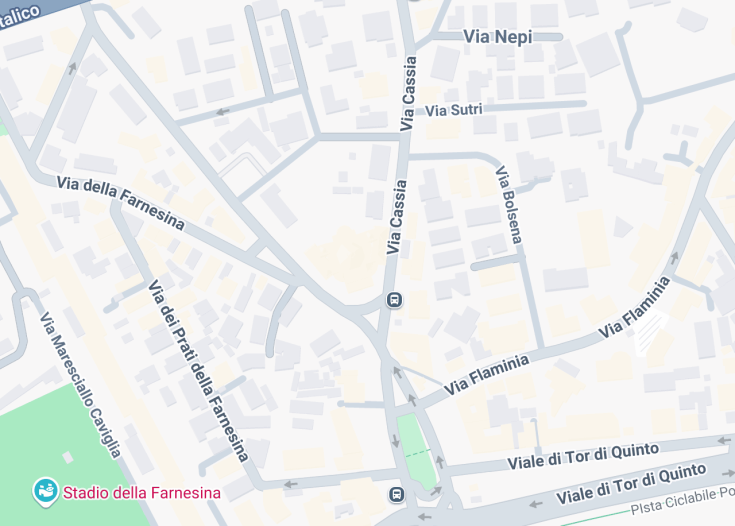The Chiesa della Gran Madre di Dio in Rome stands as a prominent example of modern neoclassical architecture. Commissioned by Pope Pio XI, it was completed in 1933, commemorating the XV centenary of the Council of Ephesus. This magnificent church reflects deep religious significance, representing the divine motherhood of Mary and serving as a key location for the local Catholic community.
Visitors should be aware that the Chiesa della Gran Madre di Dio is located near the bustling area of Ponte Milvio, making it a perfect stop during a leisurely walk. Explore the vibrant surroundings, which offer various dining and shopping options.
It is advisable to check the official website for any scheduled services or events prior to your visit. Attending a mass or special ceremony can provide a deeper understanding of the church’s significance and active role in the community.
Chiesa della Gran Madre di Dio: Architectural and Cultural Significance
The Chiesa della Gran Madre di Dio exhibits a stunning example of Neoclassical architecture, designed by architect Cesare Bazzani. Its prominent façade is characterized by a large pronaos flanked by monumental columns with Corinthian capitals, leading to an impressive triangular pediment featuring the coat of arms of Pope Pius XI. This architectural grandeur is enhanced by two smaller bell towers that mirror the massive central dome—which itself is an octagonal structure topped by a lantern, allowing natural light to illuminate the interior.
The interior is structured around a Greek cross layout, providing a harmonious and calming atmosphere suitable for worship. In the semicircular apse, five large semicircular windows flood the space with light, adorned with the inscription “SANCTA MARIA MATER DEI ORA PRO NOBIS” encapsulating the church’s dedication to the Mother of God. A noteworthy fresco by painter Federico Morgante decorates the apse, enhancing the spiritual ambiance with its artistic representation of Marian devotion.
History
1931-1933: Construction Era
The construction of the Chiesa della Gran Madre di Dio commenced in 1931 and was completed by 1933 as a commemorative structure for the 15th anniversary of the Council of Ephesus. Pope Pius XI initiated the project to honor the dogmas regarding the divine motherhood of Mary, a significant marker in Catholic theology.
1937: Consecration
On December 12, 1937, the church was formally consecrated by Bishop Francesco Beretti. This event marked its official recognition as a place of worship and solidified its role in the religious landscape of Rome. Subsequently, it was assigned as the parish church, affirming its importance in the local community.
1965: Cardinal Title
The church gained prominence in 1965 through the establishment of its cardinal title, “Gran Madre di Dio”. This title was conferred to enhance the ecclesiastical significance of the church, making it a pivotal site within the broader context of the Roman Catholic Church.
2007-Present: Recent Developments
Currently, the church is led by Monsignor Luigi Storto, who was appointed as the parish priest in 2016. The Chiesa della Gran Madre di Dio continues to serve as a vital place for worship as well as community gatherings, maintaining its historical and spiritual legacy.
Attractions and Activities at Chiesa della Gran Madre di Dio
Visitors to the Chiesa della Gran Madre di Dio can engage deeply with its captivating history and architecture. The church offers services that allow people to connect on a spiritual level, including regular mass and special liturgical events. Guided tours provide a comprehensive insight into its artistic and religious significance, focusing on the intricate details of its design, such as the frescoes and stained glass windows. Additionally, the peaceful ambiance creates an inviting space for personal reflection and prayer.
The Artistic Representation in the Apse
The apse of Chiesa della Gran Madre di Dio features a significant fresco by Federico Morgante, reflecting the theological depth of Marian devotion in Catholicism. This artwork not only enhances the aesthetic appeal of the church but also embodies the core values of faith and reverence. The imagery encapsulated within this fresco serves as a spiritual reminder of Mary’s role as the Mother of God, integral to the church’s dedication.
General informations
Location
The Chiesa della Gran Madre di Dio is located on the right bank of the Tiber River, near the confluence of Via Flaminia and Via Cassia. It is close to the iconic Piazzale di Ponte Milvio, a site historically significant for the battle between Constantine and Maxentius in 312 AD, marking a new age for the Catholic Church.
Address:
Via Cassia, 1, 00191 Roma RM, ItalyVisiting Information
The church is open to the public, allowing visitors to explore its grandeur without strict closing times. For the best experience, it is recommended to visit in the morning or late afternoon when the light enhances the architecture.
How to reach Chiesa della Gran Madre di Dio
Car
The Chiesa della Gran Madre di Dio can be easily reached by car. Parking is available at nearby facilities for a nominal fee.
| Route | Distance | Travel time |
|---|---|---|
| From Rome City Center | 5 miles (8Km) | 20 minutes |
| From Rome Termini Station | 4 miles (6Km) | 15 minutes |
| From Fiumicino Airport | 20 miles (32Km) | 40 minutes |
Public Transport
Accessing Chiesa della Gran Madre di Dio via public transport is convenient. The nearest bus stop is just a short walk away.
| Route | Distance | Travel time |
|---|---|---|
| From Colosseum Metro Station | 4 miles (6Km) | 30 minutes |
| From Vatican City | 3 miles (5Km) | 25 minutes |
| From Piazza Navona | 2 miles (3Km) | 20 minutes |
Accessibility and limitations
The Chiesa della Gran Madre di Dio is generally accessible to visitors, although some areas might pose challenges for those with mobility issues due to its architectural features.
Accessibility
Limitations
- Some areas of the church may have uneven surfaces.
- The church can become crowded during mass and special events.
Notes to visitors
- Photography is allowed, but be respectful of the worshippers.
- Dress modestly, as this is a place of worship.
Common questions
What architectural style is the Chiesa della Gran Madre di Dio?
The Chiesa della Gran Madre di Dio in Rome is designed in the Neoclassical architectural style. This style is known for its grandeur and elegance, often characterized by the use of columns, symmetrical shapes, and a preference for simple forms that echo the classical architecture of ancient Rome and Greece.
Specifically, the church features a prominent portico with a triangular pediment supported by Corinthian columns, which is a hallmark of Neoclassical design. Inside, the church’s layout emphasizes a Greek cross plan, and the use of large windows enhances the open, airy feel typical of this style. The striking octagonal dome topped with a lantern further exemplifies the Neoclassical influence in its design.
What is the significance of the Gran Madre di Dio title?
The title ‘Gran Madre di Dio’ translates to ‘Great Mother of God’ and holds significant theological importance in the Catholic Church. It honors the Virgin Mary, recognizing her unique role as the mother of Jesus Christ, who is considered both divine and human.
Historically, the title is associated with the dogmas established during the Council of Ephesus in 431 AD, which affirmed Mary’s status as Theotókos, meaning ‘God-bearer’. The establishment of the Chiesa della Gran Madre di Dio was intended as a commemoration of the 15th anniversary of these important doctrines. This reinforces the church’s function not only as a place of worship but as a reminder of the centrality of Mary in the Catholic faith, particularly in her role in salvation history.
What features can visitors expect to see inside the church?
Inside the Chiesa della Gran Madre di Dio, visitors will encounter a serene and beautifully designed space that reflects its Neoclassical architecture. The interior showcases a Greek cross plan, which allows for a harmonious layout. The main altar is often the focal point, and the semicircular apse is adorned with five large arched windows that allow natural light to flood the space.
One of the highlights is the breathtaking fresco in the apse created by the artist Federico Morgante, which adds to the spiritual atmosphere of the church. Additionally, the sides of the altar feature intricate details, and you’ll find various religious iconography that speaks to the themes of Marian devotion, including the inscription “SANCTA MARIA MATER DEI ORA PRO NOBIS” (Holy Mary, Mother of God, pray for us) elegantly displayed.
The church also includes notable decorative elements that contribute to its overall aesthetic, making it a place of both prayer and artistic appreciation.
Is the Gran Madre di Dio church a popular destination for tourists?
Yes, the Chiesa della Gran Madre di Dio is a popular destination for tourists visiting Rome. Its striking Neoclassical architecture and significant religious heritage attract visitors who are interested in both art and spirituality. The church stands out not only for its impressive design but also for its connection to the history of the Catholic Church and its reverence for the Virgin Mary.
The location near the confluence of historic roads gives it additional visibility, making it a convenient stop for those exploring the area around Ponte Milvio. Many visitors appreciate the opportunity to experience a quieter and more reflective atmosphere compared to other, more crowded churches in Rome. The church serves as a peaceful place for contemplation, making it appealing to a variety of tourists looking to delve into the cultural and religious dimensions of their visit to the Eternal City.
What events are typically held at the Chiesa della Gran Madre di Dio?
The Chiesa della Gran Madre di Dio regularly hosts a variety of religious events and ceremonies, reflecting its active role within the Catholic community. Key events include regular Sunday Mass and special liturgical celebrations. These gatherings not only mark the typical worship activities but also incorporate significant feast days related to Mary and other saints.
Throughout the liturgical calendar, the church may observe special holy days that involve processions, themed services, and community gatherings. Additionally, the church may participate in broader diocesan events, offering opportunities for spiritual enrichment through retreats or evenings of reflection.
Moreover, the church often welcomes visitors who wish to participate in these gatherings, providing a chance to experience the local religious atmosphere and community spirit firsthand.

Is the Chiesa della Gran Madre di Dio in Rome, Italy worth visiting?
The Chiesa della Gran Madre di Dio is definitely worth visiting for tourists who appreciate stunning architecture and religious history. This church, constructed between 1931 and 1933, showcases impressive neoclassical design by the architect Cesare Bazzani. Its location near the historic Ponte Milvio adds to its allure, as this area holds significant importance in early Christian history.
Inside, you’ll find beautiful frescoes and a sense of peace that can enhance any visit. Additionally, the church’s dedication to the Mother of God ties it to deep-rooted Christian traditions, celebrated during the 15th centenary of the Council of Ephesus. This makes it more than just a stop on a tour; it’s a place steeped in meaning. A visit here is both enriching and inspiring.








